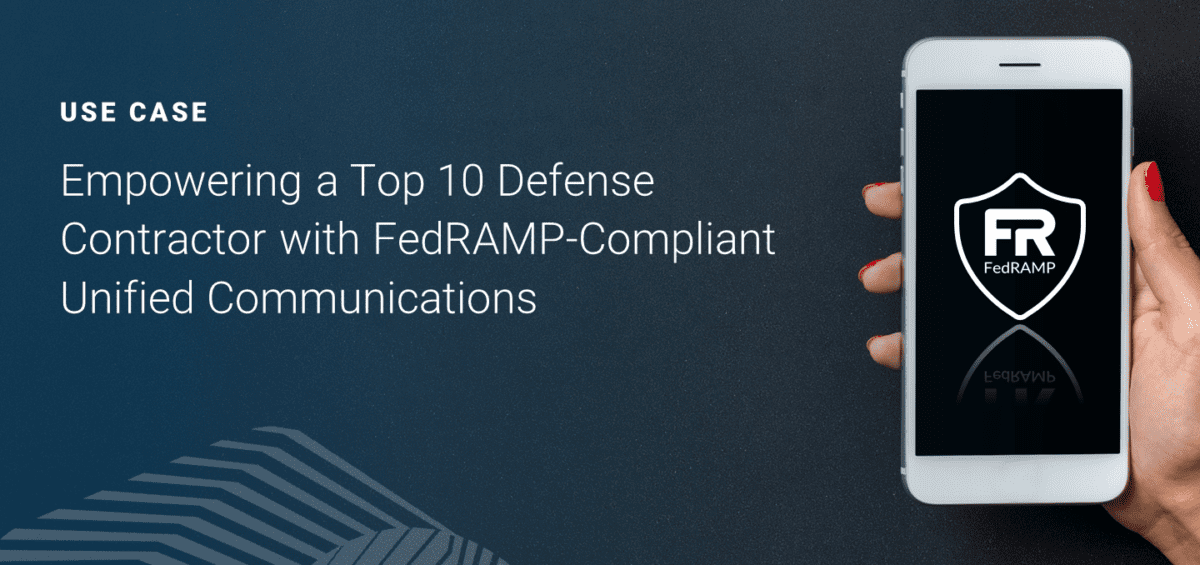Client Profile
A Top 10 Federal Defense Contractor with over 20,000 employees.
Previous State
The client was managing a complex environment with large Avaya and Cisco infrastructure footprints for PBX and Contact Center. They utilized multiple SIP carriers and numerous collaboration tools, including Microsoft Skype for Business, Microsoft Teams, and Cisco WebEx.
Need for Change
Like most enterprises, this client had a voice, messaging, and collaboration environment comprised of disparate, primarily premises-based, technology platforms. The enterprise had grown through several acquisitions of organizations utilizing different IT solutions. Disparate platforms were also symptomatic of business units having unfulfilled requirements and sourcing solutions independently. The myriad of systems deployed caused significant cost and operational inefficiency and endangered the client with potential security risks. The client’s suboptimal environment posed significant challenges with supporting the end-user community. To mitigate these challenges, the enterprise needed a unified solution. They engaged ARG to build, author, and manage a Unified Communications and Contact Center Request for Proposal (RFP).
Key Critical Requirements
The client required a FedRAMP environment that provided a seamless consolidation of collaboration/conferencing/voice and delivered cost efficiencies. High-touch service and support to manage the user transition and migrate existing legacy services were necessary to enable the client’s staff to focus on existing priorities. Management also sought the ability to easily scale in support of their acquisition and growth roadmap. The final solution requirements were ease of use as well as ease of administration.
The ARG Approach – A Process as Much as a Solution
ARG helped the client complete a survey of their business needs and conducted stakeholder meetings to collect use case information from the various business units. During the requirements gathering phase, a steering committee was identified to represent stakeholder needs in the evaluation of a new platform. ARG used the captured data and client requirements to identify providers who could take a broad approach to solving the client’s core needs. The supporting ARG team reviewed the list of prospective partners and solution designs with the client to finalize the list of bidders.
ARG then authored a formal RFP covering all elements of the client’s key requirements, which was then approved by the client and sent to the down-selected vendors. Using the client’s critical criteria as a guide, the ARG analyst team aggregated and normalized the vendor RFP response data into a weighted scoring template. After conducting the initial review of the response data with the client, ARG facilitated the down selection of finalists and then coordinated “vendor days” for those providers to review their solutions with the client.
ARG created a scorecard for the client’s steering committee and stakeholders to help track their feedback during the sessions. Once scoring was completed by all participants, ARG aggregated the scorecard data for review with the client, which was then used to identify their next round of down-selections. They also provided the client with unique perspectives and invaluable context around the service provider information presented.
Furthermore, ARG assisted the client in negotiating financial models and finalizing proposals. They then delivered a comprehensive total cost of ownership/return on investment (TCO/ROI) analysis considering all of the client’s current contracts, which helped bring the executive team to a final decision. Using ARG’s unlimited executive access, the team set up multiple meetings between the client and provider C-suites to ensure both parties understood the importance of the project.
In the negotiation process, ARG navigated multiple provider contract end dates and early termination penalties to determine the optimal installation. ARG also saved the client $4.4M over the life of the contract.
The Solution
The final solution fit the established criteria and provided a top-notch user experience. The client’s executive leadership team wanted a simple, collaboration-first solution. It needed to be able to support a wide range of use cases, from day-to-day needs through advanced training and video room system interoperability and support. ARG negotiated industry-leading flexibility in the ramp schedule and terms to help make the migration easy and the business case strong. Lastly, FedRAMP compliance was key. Not only did the selected provider’s solution check the capability boxes best, but they were also the only vendor capable of delivering a true Unified Communications as a Service (UCaaS) solution that is 100% FedRAMP-compliant.
Ensuring Success
ARG’s value delivery strategy does not stop at the selection process. The ARG Project Experience team took over post-contract execution. With years of UCaaS and collaboration deployment experience in their pockets, ARG project and engineering resources partnered with the client to develop a technically sound and efficient deployment plan. ARG’s guidance on how best to phase the rollout, capture user detail, compile porting inventories and documentation, manage training, and best practices for successfully activating each location were key to this process. ARG developed a repeatable and predictably successful experience with thorough checklists and post-go-live test plans for each site. In the end, ARG helped activate thousands of users and transition 50,000 numbers onto one uniform platform across the enterprise.
To learn more about how ARG can help your organization with complex technology decisions, contact us at info@myarg.com or click on the button below to learn about the process we take enterprise clients through to get to the right solution.



